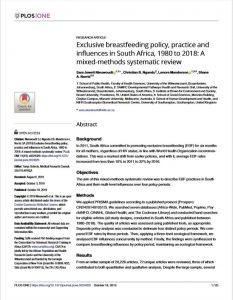
Background
In 2011, South Africa committed to promoting exclusive breastfeeding (EBF) for six months for all mothers, regardless of HIV status, in line with World Health Organization recommendations. This was a marked shift from earlier policies, and with it, average EBF rates increased from less than 10% in 2011 to 32% by 2016.
Objectives
The aim of this mixed-methods systematic review was to describe EBF practices in South Africa and their multi-level influences over four policy periods.
Methods
We applied PRISMA guidelines according to a published protocol (Prospero: CRD42014010512). We searched seven databases [Africa-Wide, PubMed, Popline, PsychINFO, CINAHL, Global Health, and The Cochrane Library] and conducted hand searches for eligible articles (all study designs, conducted in South Africa and published between 1980–2018). The quality of articles was assessed using published tools, as appropriate. Separate policy analysis was conducted to delineate four distinct policy periods. We compared EBF rates by these periods. Then, applying a three-level ecological framework, we analyzed EBF influences concurrently by method. Finally, the findings were synthesized to compare breastfeeding influences by policy period, maintaining an ecological framework.
Results
From an initial sample of 20,226 articles, 72 unique articles were reviewed, three of which contributed to both quantitative and qualitative analysis. Despite the large sample, several provinces were poorly represented (if at all) and many studies were assessed as low to moderate quality. Despite these limitations, our historical lens enabled us to explore why South African progress on increasing EBF practices has been slow. The review reflects a context that increasingly supports EBF, but falls short in accounting for family, community, and workplace influences. The findings also highlight the unintended damage caused by rapidly adopting and introducing global guidelines to an unsupported health workforce.
Conclusions
From a South African perspective, we identified geographic and methodological biases, as well as gaps in our understanding and potential explanations of inequities in EBF. Our recommendations relate to policy, programming, and research to inform changes that would be required to further improve EBF practice rates in South Africa. While our review is South Africa-specific, our findings have broader implications for investing in multi-level interventions and limiting how often infant feeding guidelines are changed.